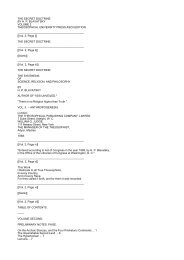You also want an ePaper? Increase the reach of your titles
YUMPU automatically turns print PDFs into web optimized ePapers that Google loves.
The Doctrine Of Eternal Life.<br />
2. Recueil de Travaux, p. 175, 1. 112.<br />
3. Ibid., t. iv., p. 44,1. 393.<br />
4. Ibid., p. 60, ll. 514, 515<br />
5. Ibid., t. v., p. 183, l. 169.]<br />
{p. lxx}<br />
certain passages in <strong>the</strong> pyramid texts seem to show that a belief in <strong>the</strong> resurrection <strong>of</strong> <strong>the</strong> natural body<br />
existed in <strong>the</strong> earliest dynasties.[1]<br />
The texts are silent as to <strong>the</strong> time when <strong>the</strong> immortal part began its beatified existence; but it is probable<br />
that <strong>the</strong> Osiris[2] <strong>of</strong> a man only attained to <strong>the</strong> full enjoyment <strong>of</strong> spiritual happiness after <strong>the</strong> funeral<br />
ceremonies had been duly per formed and <strong>the</strong> ritual recited. Comparatively few particulars are known <strong>of</strong><br />
<strong>the</strong> manner <strong>of</strong> life <strong>of</strong> <strong>the</strong> soul in heaven, and though a number <strong>of</strong> interesting facts may be gleaned from<br />
<strong>the</strong> texts <strong>of</strong> all periods, it is very difficult to harmonize <strong>the</strong>m. This result is due partly to <strong>the</strong> different<br />
views held by different schools <strong>of</strong> thought in ancient Egypt, and partly to <strong>the</strong> fact that on some points <strong>the</strong><br />
Egyptians <strong>the</strong>m selves seem to have had no decided opinions. We depend upon <strong>the</strong> pyramid texts for our<br />
knowledge <strong>of</strong> <strong>the</strong>ir earliest conceptions <strong>of</strong> a future life.<br />
The existence in heaven.<br />
The life <strong>of</strong> <strong>the</strong> Osiris <strong>of</strong> a man in heaven is at once material and spiritual and it seems as if <strong>the</strong> Egyptians<br />
never succeeded in breaking away from <strong>the</strong>ir very ancient habit <strong>of</strong> confusing <strong>the</strong> things <strong>of</strong> <strong>the</strong> body with<br />
<strong>the</strong> things <strong>of</strong> <strong>the</strong> soul. They believed in an incorporeal and immortal part <strong>of</strong> man, <strong>the</strong> constituent elements<br />
<strong>of</strong> which flew to heaven after death and embalmment; yet <strong>the</strong> <strong>the</strong>ologians <strong>of</strong> <strong>the</strong> VIth dynasty had<br />
decided that <strong>the</strong>re was some part <strong>of</strong> <strong>the</strong> deceased which could only mount to heaven by means <strong>of</strong> a<br />
ladder. In <strong>the</strong> pyramid <strong>of</strong> Teta it is said, "When Teta hath purified himself on <strong>the</strong> borders <strong>of</strong> this earth<br />
where Ra hath purified himself, he prayeth and setteth up <strong>the</strong> ladder, and those who dwell in <strong>the</strong> great<br />
place press Teta forward with <strong>the</strong>ir hands."[3] In <strong>the</strong> pyramid <strong>of</strong> Pepi I.<br />
[1. E.g., "This Pepi goeth forth with his flesh." Recueil de Travaux, t. v., p. 185, l. 169.<br />
2. The Osiris consisted <strong>of</strong> all <strong>the</strong> spiritual parts <strong>of</strong> a man ga<strong>the</strong>red toge<strong>the</strong>r in a form which resembled him exactly.<br />
Whatever honour was paid to <strong>the</strong> mummified body was received by its Osiris, <strong>the</strong> <strong>of</strong>ferings made to it were accepted by its<br />
Osiris, and <strong>the</strong> amulets laid upon it were made use <strong>of</strong> by its Osiris for its own protection. The sahu, <strong>the</strong> ka, <strong>the</strong> ba, <strong>the</strong> khu,<br />
<strong>the</strong> khaibit, <strong>the</strong> sekhem, and <strong>the</strong> ren were in primeval times separate and independent parts <strong>of</strong> man's immortal nature; but in<br />
<strong>the</strong> pyramid texts <strong>the</strong>y are welded toge<strong>the</strong>r, and <strong>the</strong> dead king Pepi is addressed as "Osiris Pepi." The custom <strong>of</strong> calling <strong>the</strong><br />
deceased Osiris continued until <strong>the</strong> Roman period. On <strong>the</strong> Osiris <strong>of</strong> a man, see Wiedemann, Die Osirianische<br />
Unsterblichkeitslehre (in Die Religion der alten Aegypter, p. 128).<br />
3. ###. Maspero, Recueil de Travaux, t. v., p. 7, l. 36.]<br />
{p. lxxi}<br />
<strong>the</strong> king is identified with this ladder: "Isis saith, 'Happy are <strong>the</strong>y who see <strong>the</strong> 'fa<strong>the</strong>r,' and Nephthys<br />
saith, 'They who see <strong>the</strong> fa<strong>the</strong>r have rest,' speaking unto <strong>the</strong> fa<strong>the</strong>r <strong>of</strong> this Osiris Pepi when he cometh<br />
forth unto heaven among <strong>the</strong> stars and among <strong>the</strong> luminaries which never set. With <strong>the</strong> uræus on his<br />
brow, and his book upon both his sides, and magic words at his feet, Pepi goeth forward unto his mo<strong>the</strong>r<br />
Nut, and he entereth <strong>the</strong>rein in his name Ladder."[1] The gods who preside over this ladder are at one<br />
time Ra and Horus, and at ano<strong>the</strong>r Horus and Set. In <strong>the</strong> pyramid <strong>of</strong> Unas it is said, "Ra setteth upright<br />
http://www.sacred-texts.com/egy/ebod/ebod05.htm (12 <strong>of</strong> 21) [8/10/2001 11:23:21 AM]

















